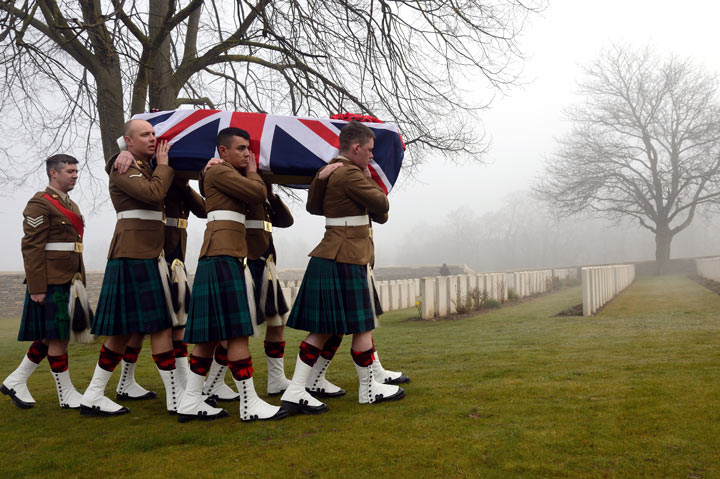LOOS-EN-GOHELLE, France – Scotsman William McAleer had been in France barely two months when, just before sunrise on Sept. 25, 1915, he was among thousands of other troops who launched the British army’s largest attack so far of World War I.

By the next day, the 22-year-old private from a seaside town in Fife was dead. Almost 60,000 British troops died in the Battle of Loos, and a third disappeared with no known grave.
McAleer was one of them, until nearly a century later, when workers building a new prison turned up his remains in a common grave.
On Friday, McAleer and 19 other still unidentified British soldiers were reburied with full military honours in a ceremony in this sleepy northern French village, close to where they fell in battle. The ceremony was a reminder of the horrors of a war that devastated this continent 100 years ago – and as a reminder of why many Europeans today are so wary of seeing a new conflict on their eastern flank in Ukraine.
A bagpiper played “Amazing Grace” as McAleer’s coffin was carried through the fog-shrouded cemetery Friday morning by six Royal Regiment of Scotland soldiers wearing kilts. A distant relative of McAleer’s, Stephen McLeod, represented McAleer’s family at the funeral.
“He was my great uncle. My gran gave me his Mass card when I joined the army,” said McLeod, 47, of Cowdenbeath, Fife.
“In the centenary year (of the start of the war), to be able to remember those who’ve fallen, and for it be your kith and kin, how can you find the words?” McLeod said after the ceremony.
Around 200 people, some from as far away as Australia, turned out for the hour-long ceremony. Many were history buffs who’d heard about the ceremony on the website of the Western Front Association, a historical society.
“We’ve been doing this for 30 years,” said Iris Oakey, an Englishwoman who attended with her brother, John Mawson. Their grandfather fought further north on the Western Front at Ypres in Belgium. Together they’ve visited World War I sites in over a dozen countries. “Every cemetery has a story, every single one,” Oakey said.
The Battle of Loos was a failed attempt to break through the German line. It was memorialized in English poet Robert Graves’ autobiography “Good-bye to All That.” Rudyard Kipling’s son John also died here, and is buried at another British cemetery nearby. It was Kipling who proposed the phrase “Known Unto God” for unidentifed casualties that is engraved on limestone tombstones across the Western Front.
First World War remains still turn up regularly, during construction projects or in the spring planting season. More than 700,000 soldiers killed in the Great War were never found, their remains now part of the earth along the 600-kilometre-long (360-mile-long) route of the Western Front.
In January a nearly complete skeleton of an unidentified French soldier was unearthed at the Memorial of Verdun, where construction is underway on renovations to mark the centenary of the war. Last May remains of 26 French soldiers were found in Fleury-devant-Douaumont, one of France’s “ghost villages” that were entirely destroyed by the war. And in 2012, another French soldier’s remains turned up during construction of a canal that stretches 100 kilometres (60 miles) along the old Western Front.
What makes McAleer’s case especially notable is that unlike most of these other cases, investigators were able to reach back through history and give him a name, a history, and now, a proper grave.
In October 2010, workers building a new prison a few miles east of Loos-en-Gohelle turned up the remains. They were found along with 19 other British and 30 German soldiers, carefully laid out in a common grave that investigators determined was dug by the German side, based on where the front line had then run.
McAleer was identified by investigators working for the Commonwealth War Graves Commission, or CWGC, thanks to an ID tag found with his remains. Efforts to identify the others were unsuccessful, although investigators were able to trace half of them to a specific regiment. Their graves, like the majority of the graves in Loos’ British cemetery, will bear the epitaph “Known Unto God.”
The German remains have been handed over to VDK, the German war graves body, which is working to identify them.
Members of the Royal Regiment of Scotland’s 2nd Battalion, the modern-day descendants of McAleer’s Royal Scottish Fusiliers, were on hand Friday to honour their fallen comrades. Representatives of regiments for the other 10 soldiers whose regiments could be traced also participated.
Carl Liversage, a CWGC official based in France, said, “You can’t describe the feeling of finding the casualty and seeing the headstone and saying ‘I think I made a difference.”‘



Comments